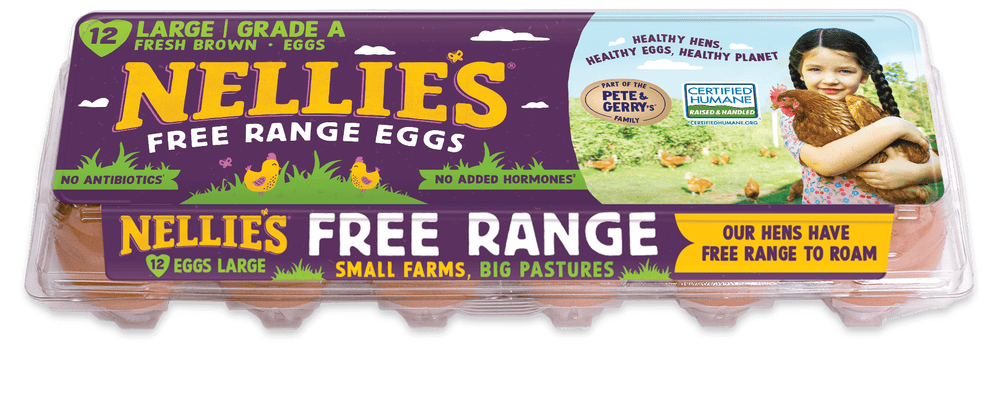


6g
Protein
70
Calories
0g
Sugar


- Calories 70
- Total Fat 5g
- Saturated Fat 1.5g
- Trans Fat 0g
- Cholesterol 185mg
- Sodium 70mg
- Total Carb. 0g
- Dietary Fiber 0g
- Total Sugars 0g
- Protein 6g

A day in the life of a pasture-raised hen

Foraging for delicious snacks
Our pasture-raised hens enjoy a well-rounded, species-appropriate diet of treats ranging from juicy grubs to tasty greens found in the pasture. On our farms, every bird (not just the early one) gets the worm.

Soaking up the sunshine
Spending their days on pasture gives our flocks plenty of time to catch some rays, whenever they please. All that sun not only makes for a healthier hen and a sunnier disposition, but boosts the amount of vitamin D in her eggs.

Endless hours of socializing
Hens are naturally social creatures and love to “flock” together in small groups. With 108 square feet of pasture area per bird, they have endless social hour locales to choose from—and no shortage of opportunities to squawk about the latest happenings on the farm.

Laying an egg
Hens lay one egg every 24-28 hours, so they enjoy minimal working hours, with the vast majority of their time dedicated to soaking up the sun and lounging about on pasture. Striking the perfect work-life balance is key for us all, and our flocks have it all figured out.

Dust bathing for self-care
More than just a spa day ritual for these self-care divas, dust baths serve a critical role in maintaining optimal health. They help keep our ladies clean, as well as absorb excess oil and moisture to keep them looking and feeling fresh.
Rave Reviews


FAQ
Frequently asked questions







OUR EGGS
-
Should I eat eggs past the best before date?
The best course of action for determining whether your eggs are safe to eat is to check the best by date, along with a few pieces of information that can help determine their freshness. Once a carton has passed its best by date, or 45 days from being processed, those eggs are considered expired and we’re unable to guarantee any safety or results from consuming them.
According to the U.S. Dept. of Agriculture (USDA): “Many eggs reach stores only a few days after the hen lays them. Egg cartons with the USDA grade shield on them must display the “pack date” (the day that the eggs were washed, graded, and placed in the carton). The number is a three-digit code that represents the consecutive day of the year (the “Julian Date”) starting with January 1 as 001 and ending with December 31 as 365. When a “sell-by” date appears on a carton bearing the USDA grade shield, the code date may not exceed 45 days from the date of pack.”
For a full explanation of the details on our eggs' best before date and tips for telling whether your eggs are still good, check out our blog.
-
Do you wash the eggs? Does that impact their quality?
Due to FDA regulations and food safety requirements, we must wash our eggs before consumers can receive them. We use a light, organic approved soap to wash our egg shells. After the eggs are washed, they are sanitized with a mild chlorine solution. Our Quality Assurance team monitors critical control points like wash- and rinse-water temperature, detergent levels, etc. This does remove the cuticle (or bloom) from the egg, which is a natural protective coating that typically remains on unwashed eggs, but we must wash them per FDA requirements.
-
How does nutrition impact yolk color?
Natural fluctuations in yolk color can happen for a variety of reasons: flock age, changes in weather, time of year, and even flock location. The bugs that our hens peck at also can play a part in the yolk color as an unpredictable increase of protein in their diet. Each flock and individual hen is unique, which tends to be reflected in their eggs.
We routinely check our free range and pasture-raised eggs for yolk color and find they are typically much darker than caged, factory farmed eggs. We're committed to offering our hens a more natural and varied diet, but sometimes these humane practices can lead to lighter yolks from time to time.
-
What causes blood spots in an egg?
Blood spots are caused by the rupture of a blood vessel on the yolk surface when it’s being formed. Typically, the presence of blood spots is an indication of a very fresh egg. As an egg ages, the blood spot diffuses across the white and becomes almost undetectable over time.
Blood spots can occur in up to 6% of all brown shelled eggs. From time-to-time, the incidence of blood spots in eggs increases above the normal, 6% rate, when the hens in a flock get excited by changes in lighting, changes in temperature, or when they catch a cold. Candling methods reveal most eggs with blood spots and those eggs are removed, but even with electronic spotters, (as we have) it is impossible to remove them all. We also carefully inspect the eggs with cameras that check the interior when we package them but due to shell density, color, contrast and depth, some of these eggs do get through. Sometimes, if the spot is small, it can be cut out with the tip of a knife and the egg is still perfectly fine to eat.
-
What causes double yolks?
Double yolks are fairly rare (about 1/1000) and double-yolked eggs tend to be very, very large. These eggs are typically are graded as ‘Super Jumbo’ due to their size. Double yolks primarily come from younger flocks whose bodies are just learning how to lay eggs. All of our farm fresh eggs are run through the sorting machine together, and any eggs identified as Super Jumbos are sent to the first packing station to be packed by hand because they're too big for the machine.
The hand packing station fills Jumbo cartons with Super Jumbos all day long, placing each carton in the same case, which explains why rare double-yolked eggs often end up in the same carton. All of these larger eggs are packaged together as Jumbos (even though they are technically Super Jumbos), and over 50% tend to have double yolks.
-
Why do some eggs float in water?
Any egg that floats in water is likely very old and should not be eaten. Every egg contains an air cell that occurs naturally and expands as the egg ages. Once enough oxygen has had time to permeate the shell, the air cell can grow large enough to keep the egg afloat in water. We suggest tossing any eggs that float in water, or learning more about the water test for checking egg freshness on our blog here.
-
Are your liquid egg whites pasteurized?
Our 16 ounce containers of liquid egg whites are pasteurized and are great for most baking applications. Want to find locations where our egg whites are sold? Check here.
-
Can I use your liquid egg whites to make meringue desserts?
Because of the effects of the pasteurization process on the protein structure, our liquid egg whites will not whip to soft or stiff peaks and are not recommended for any meringue-style recipes. This includes meringue cookies, meringue toppings, meringue-based frostings, and whipped egg white components in recipes such as fluffy Belgian waffles.
When you whip fresh egg whites, air bubbles generated by the whipping action are held in suspension by protein structures created within the egg white, producing a fluffy and light meringue that will also hold stiff peaks. The pasteurization process changes the structure of those proteins, so they can no longer work together to hold onto the air bubbles. As a result, when you whip the pasteurized egg whites, you will be able to froth and foam them to a degree, but they will continue to stay fairly runny (even with extended whipping).
These foamy, pasteurized whites do work great for mixed drinks and cocktails as they are safe to consume raw, but for making those classic, crunchy clouds of meringue or silky whipped topping, we recommend good old-fashioned fresh egg whites for the best result.
-
How do I measure your liquid egg whites?
To substitute for 1 large egg white, use 2 tablespoons of our liquid egg whites. To substitute for 1 large whole egg, use 3 tablespoons of our liquid egg whites.
-
How many eggs does a hen lay per day?
It's right around 1 egg per day for most hen breeds. A typical flock will average around 307 eggs per hen over the first 52 weeks of laying, which will slow down a bit as the hens age.
-
What causes different egg shell colors?
Egg shell color is determined by the breed of hen and is often related to the color of the feathers over the hen’s earlobes. Brown hens, like those on our farms, typically lay brown eggs and white chickens lay white eggs (although there are a few breeds of white chickens with brown ear-feathers that lay brown eggs). However, it's important to note that shell color has nothing to do with the nutritional content or quality of an egg.